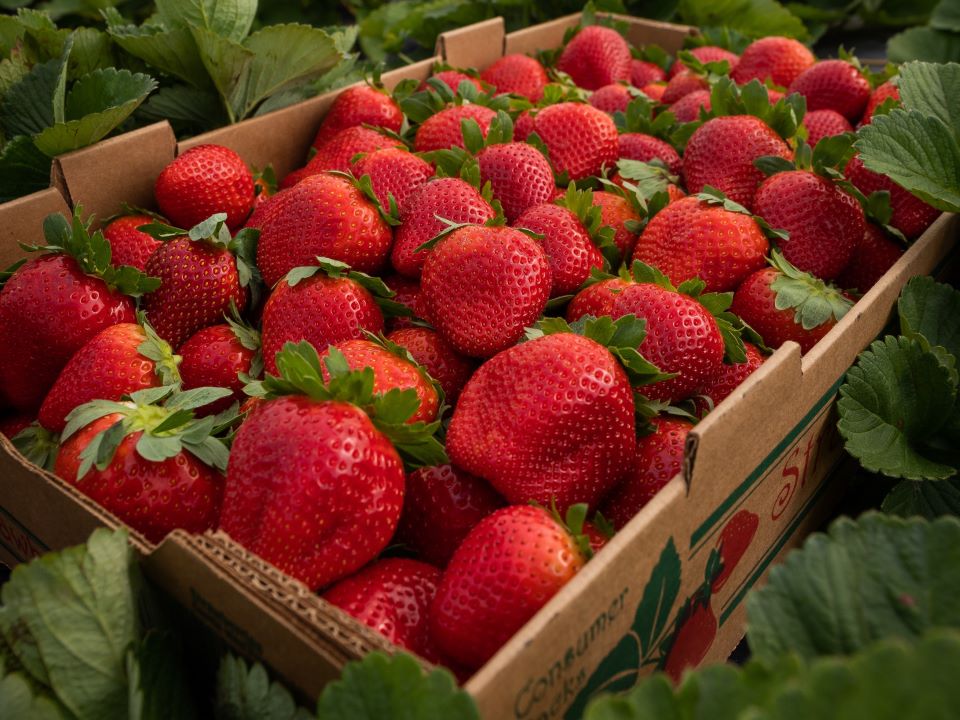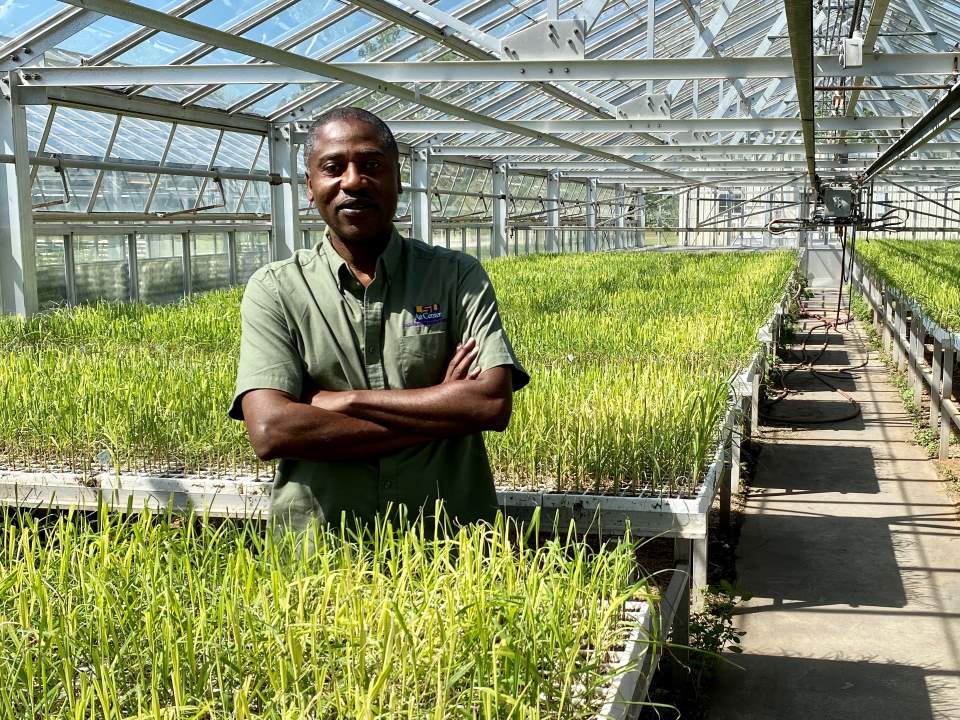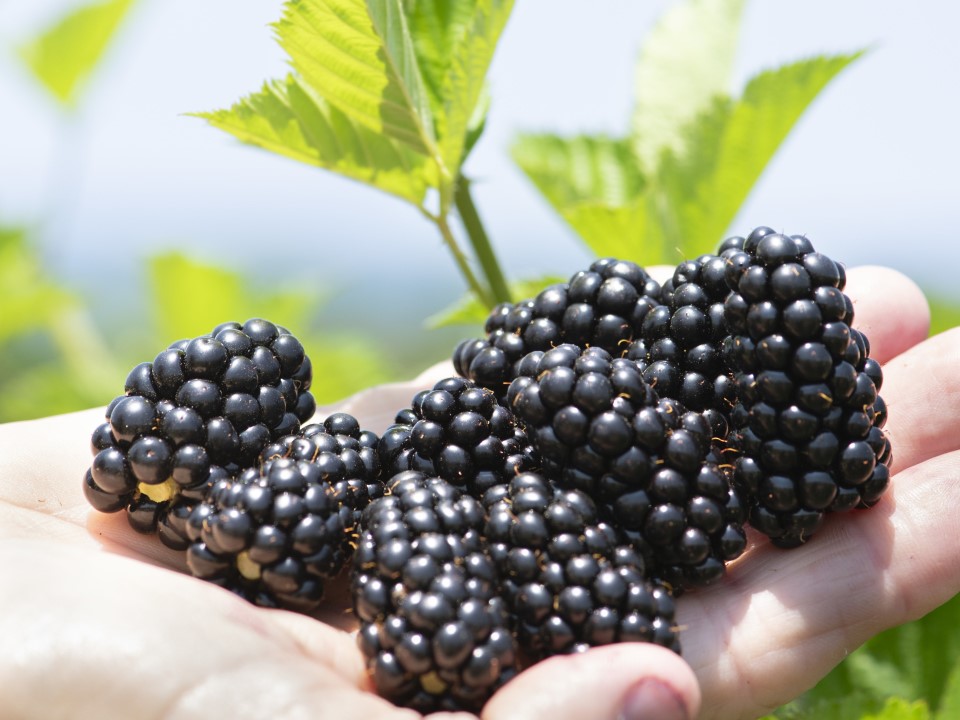Bigger, more bountiful, better flavor, pest, drought and cold resistant – precision breeding is transforming the fruits and vegetables farmers bring to our tables. Here, we take a look at three distinct programs and their efforts to help farmers feed the world.
Florida Berry Breeding
Written by: Hope Miller, UF/IFAS

A box of freshly picked strawberries at the UF/IFAS Gulf Coast Research and Education Center in Wimauma, FL. Credit: UF/IFAS Photography.
Researchers at the University of Florida Institute of Food and Agricultural Sciences (UF/IFAS) are using a mix of traditional breeding methods and next-generation science to improve strawberry and blueberry varieties.
Florida is the second leading strawberry producer in the U.S., following California. Florida strawberry varieties are found on every continent except Antarctica.
Recently, the white-fleshed strawberry colloquially known as the pineberry made a splash in markets. Other cultivars bred for color, shape, flavor and yield are also very popular.
“For many years we have been meeting the needs of our growers, continually providing them with better varieties,” Vance Whitaker, a UF/IFAS strawberry breeder, said. “On the consumer side, I am most proud that we have continued to increase flavor, which is hopefully encouraging people to eat more strawberries. You can’t go wrong by eating more of something that is so good for you.”
The UF/IFAS blueberry breeding program started in the 1940s, revolutionized the industry with now widely planted “southern highbush” cultivars, and is now using precision breeding to develop varieties with characteristics such as drought tolerance and ability to be machine harvested.
Florida blueberries are the earliest U.S.-grown berries to market in the year, providing fresh fruit in late spring.
UF President Ben Sasse recently committed $2 million to launch a Plant Transformation Center to facilitate the rapid development and commercialization of genetically improved crops.
Sugarcane And Rice Breeding In Louisiana
Written by: Tobie Blanchard, LSU Ag Center

LSU AgCenter sugarcane breeder Collins Kimbeng stands amidst potential new sugarcane varieties, which are now seedlings at the AgCenter Sugar Research Station in St. Gabriel. Credit: Kyle Peveto, LSU AgCenter
In a pocket of central Louisiana, a surprising crop for that area is taking root — sugarcane.
Sugarcane, a tropical crop, has traditionally been limited to south Louisiana. But by using precision breeding techniques, Louisiana State University AgCenter researchers are developing sugarcane varieties that can withstand colder temperatures. Now, central Louisiana is home to the northernmost sugarcane fields in the world.
Across the southern region, scientists with land-grant universities are applying precision breeding methods and tools to improve the performance of crops.
Employing DNA markers, gene editing, drone imaging and advanced statistical modeling, precision breeding allows crop breeders to more easily identify and deploy specific traits in their varieties.
LSU AgCenter sugarcane and rice breeders are using molecular markers to map genes and select desirable characteristics for the crop varieties.
LSU AgCenter sugarcane breeder Collins Kimbeng said wild sugarcane germplasm collected in other parts of the world have genes that could tolerate colder environments. Using precision breeding techniques, researchers were able to insert the cold-tolerant genes into high sugar-producing varieties.
“The regular sugarcane that produces a lot of sucrose is not climate resilient, but the wild species is,” Kimbeng said. “With those crosses, and then through selection and backcrossing, over several generations, they’ve been able to slowly increase the genes for climate resilience while maintaining the genes for sucrose.”
LSU AgCenter rice breeder Adam Famoso said with precision breeding tools and methods he has been able to increase the scale of the rice lines he can test and do so at a lower cost than traditional methods that involved labor-intensive field testing.
“It’s so valuable because the cost to run a DNA marker in our lab is just a few cents, whereas if I wanted to evaluate a line for disease resistance, I have to increase seed, I have to put it in the field, I have to inoculate it, score it,” Famoso said. “I mean, there’s so much work that goes into it and the environment can play a factor.”
He is also improving the accuracy of selecting the traits needed in those rice lines.
The work these three universities and other Southern region land-grant universities are doing on precision breeding leads to crop varieties that can better withstand diseases and pests, have better yields and quality, and a host of other characteristics that help farmers face fewer issues in the field and at harvest time.
The LSU AgCenter, Arkansas Agricultural Experiment Station, and UF/IFAS are part of a system of 15 agricultural research centers at land-grant universities in the southern U.S. where scientists collaborate to conduct research and outreach focused on conserving the region’s natural resources and sustainably feeding a growing global population.
Blackberry Research In Arkansas
Written by: Nick Kordsmeier, Arkansas Agricultural Experiment Station

Prime-Ark® Horizon is a primocane-fruiting blackberry variety released by the University of Arkansas System Division of Agriculture in late 2020. Credit: University of Arkansas System Division of Agriculture.
Traveling north from Louisiana’s expanding sugarcane belt into Arkansas, researchers with the Arkansas Agricultural Experiment Station, the research arm of the University of Arkansas System Division of Agriculture, are using similar techniques to discover a better blackberry. Using multiple advanced genetic tools, an international team led by Arkansas fruit breeder Margaret Worthington sequenced and annotated the first-ever blackberry genome with high accuracy. The research, supported in part by the U.S. Department of Agriculture’s National Institute for Food and Agriculture, was published last year in G3, a genetics research journal published by Oxford University Press.
The research team assembled the genome of Hillquist, a wild blackberry with the unique ability to fruit on its first-year canes. Blackberry plants are perennial plants with biennial canes, or stems, that live for two years. The stems are known as primocanes in the first year and floricanes in the second year. Most blackberries only produce fruit on the floricanes. Primocane-fruiting blackberries like Hillquist flower and fruit on floricanes in the early summer and on primocanes in the late summer.
The Arkansas Fruit Breeding Program released the first primocane-fruiting varieties, Prime-Jim® and Prime-Jan®, in 2004. The completed genome has already proven helpful to the Arkansas Fruit Breeding Program, which is the largest public-sector breeding program for fresh-market blackberries in the United States.
With the diagnostic genetic markers for primocane-fruiting that have already resulted from this work, Arkansas fruit breeders are moving to streamline and advance the blackberry breeding program. Worthington says the assembled blackberry genome will help improve efficiency in the blackberry breeding process.
“Fieldwork will always be our bread and butter,” Worthington said. “But it would be a mistake not to use modern tools to advance our program, to streamline it and make it more efficient.”



